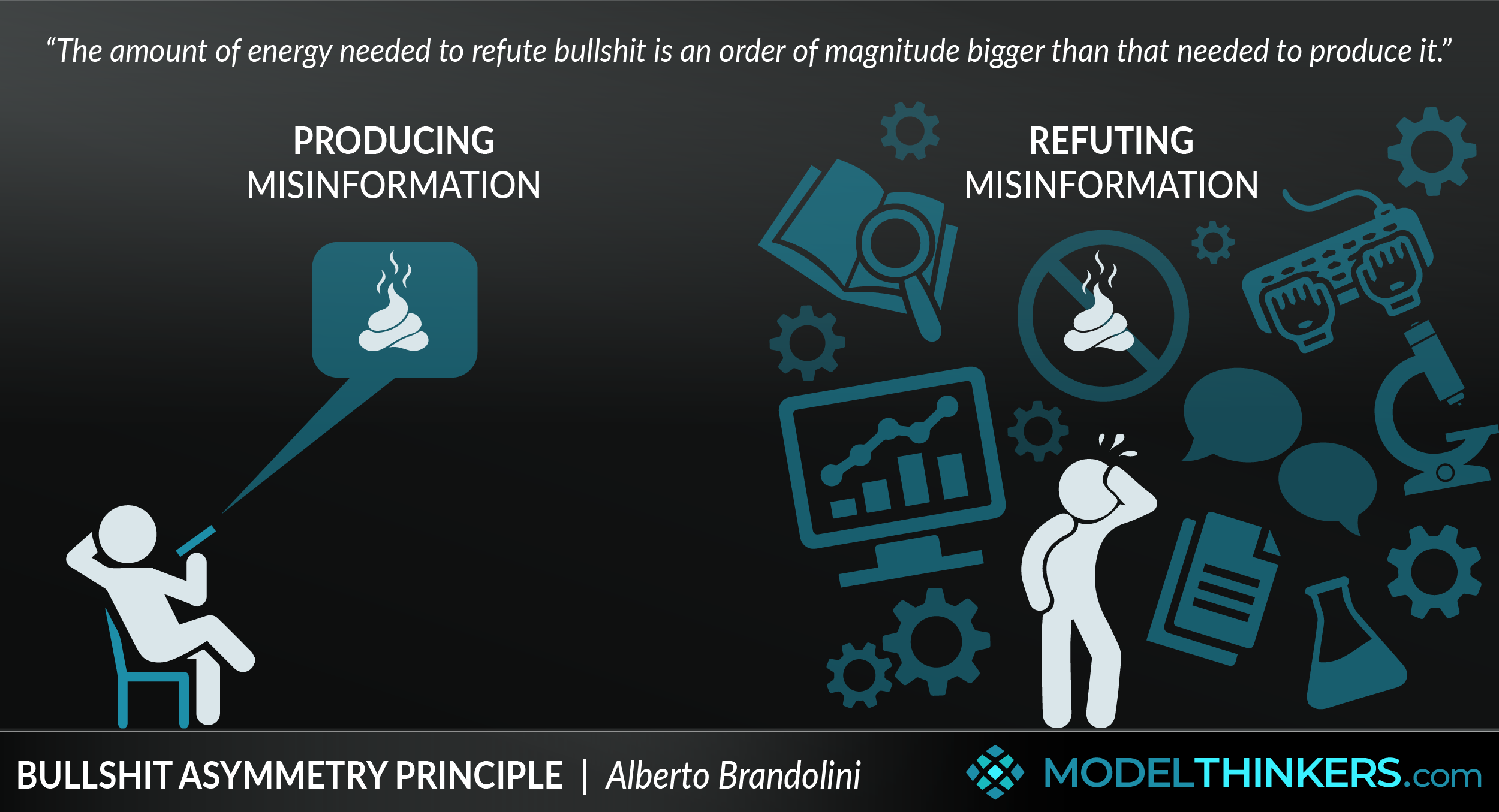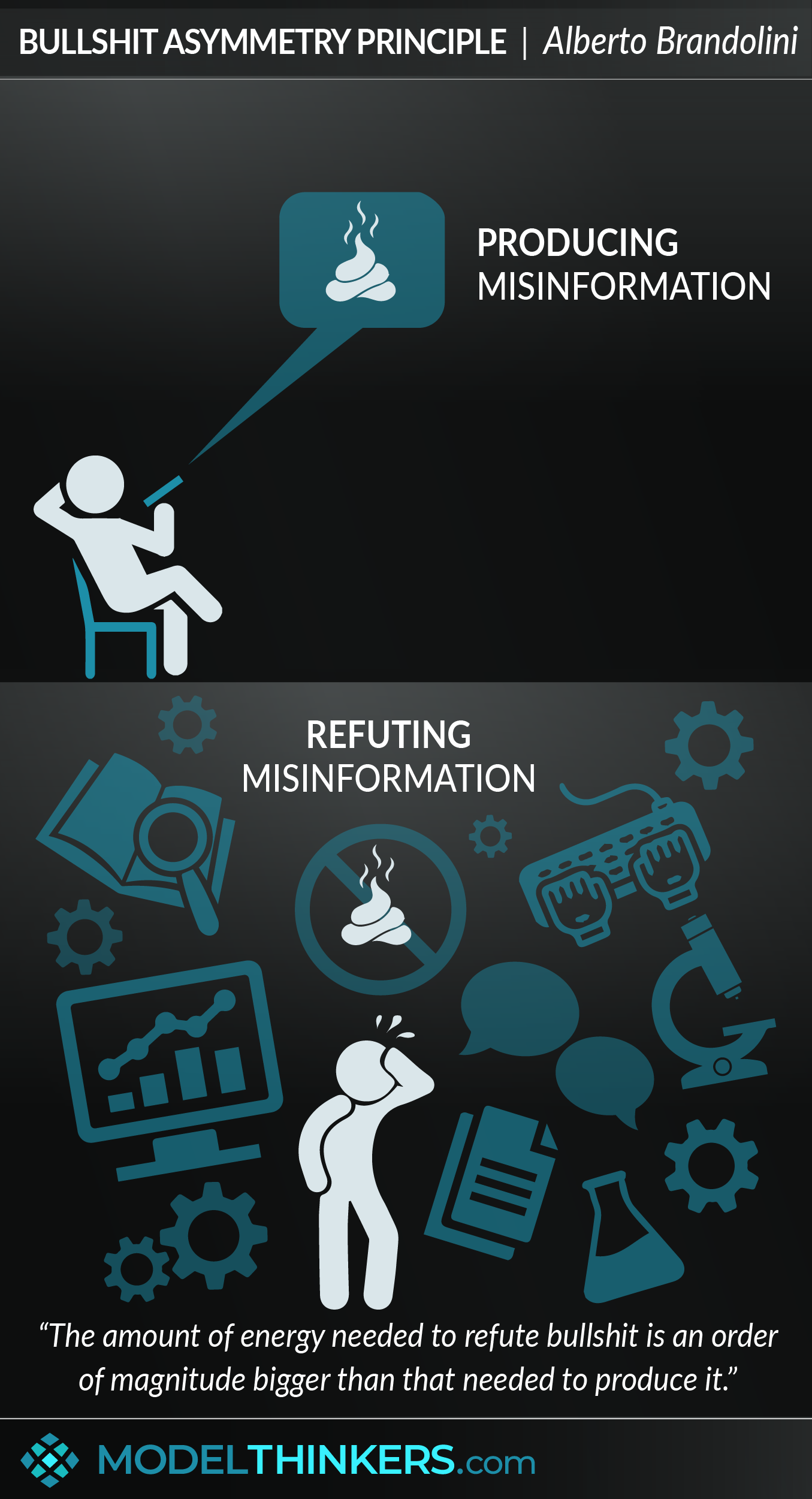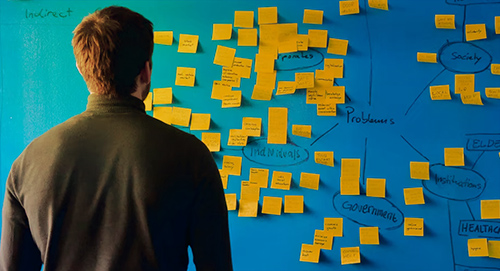

 0 saved
0 saved
 135.1K views
135.1K views








“Beware of false knowledge; it is more dangerous than ignorance.” - George Bernard Shaw.
Shaw’s warning seems more pertinent than ever, as we face growing amounts of misinformation, conspiracy theories, and unsubstantiated rumours… or bullshit for short. That’s where this concept might help.
The Bullshit Asymmetry Principle, also known as Brandolini’s Law, states that the amount of energy needed to refute bullshit is an order of magnitude bigger than that needed to produce it.
THE POWER OF FAKE INFORMATION.
We are defining bullshit as the spreading of misinformation (incorrect information) and disinformation (intentional lies). Unfortunately, the spreading of both is nothing new. As far back as the 1700s, Satirist Jonathan Swift wrote “Falsehood flies, and truth comes limping after it.” However today, in our age of social media, the spreading of such misinformation and lies has been taken to a whole new level. Ironically, The Bullshit Asymmetry Principle was coined on Twitter, by programmer Alberto Brandolini after he was inspired by Daniel Kahneman’s Thinking Fast and Slow and reflecting on the politics of the day.
Some of the main drivers behind the spreading of misinformation and disinformation include:
-
The ease of spreading false and/or unsubstantiated ideas that align with underlying fears or beliefs that leverage the Confirmation Heuristic;
-
The amplification of misinformation by silo-based communities on social media, providing deeper acceptance that comes from a peer group leveraging Social Proof;
-
Shifting the burden of proof away from the claim and towards those who wish to refute the point, simply by suggesting that ‘something is 'possible’;
-
Moving fast to fill the space to explain an event or crisis, without worrying about evidence or data, but effectively defining the Framing of the conversation and leveraging the Anchoring Heuristic;
-
Leveraging the Mere Exposure Effect, where repeating something, even a lie, helps to embed it into our understanding and belief system;
Added to these factors, is the inherent drive by many to spread misleading or unsubstantiated information. For example, such drivers are built into politics where there is a desire to rapidly ‘define the narrative of the day'. It also lies in scientific circles where academics and researchers are often under pressure to ‘publish or perish’ and focus on delivering outputs rather than ensuring that their findings are solid and able to be replicated.
IMPROVING HOW YOU COUNTER LIES AND MISINFORMATION.
There are a number of strategies that arise from understanding the Bullshit Asymmetry Principle, these include:
-
Apply the Scientific Method: this proven method involves developing an informed hypothesis, then actively testing and trying to falsify that hypothesis in order to develop a theory of how things work and what is happening.
-
Remain sceptical: use tools such as CRAAP to take a sceptical view of information, and insist on reputable evidence behind claims.
-
Weigh up the Impact vs effort of your response to bullshit: when facing misinformation, it’s important to assess the impact that it's having on a particular audience group and being more conscious about how much time you want to spend refuting it.
-
Identify potential debunking shortcuts: faced with misinformation, you might be tempted to begin deep research to develop a logical and robust counter argument. This might be required, but in some cases it might be enough to use a credible counter voice, or point to the source of the misinformation and their agenda.
-
Focus on convincing the audience not necessarily the source: It’s tempting to argue with the source of misinformation, to convince them that they’re wrong, when often the real battle lies in convincing a broader audience of that misinformation. Ensure that your counter arguments are crafted with your real audience in mind.
-
Push the burden of proof back: the Bullshit Asymmetry Principle is based on the source of misinformation putting the burden of proof (and effort) on you to refute their claim, sometimes you can turn the tables by asking for proof behind their claim. This can be taken further with one of famous scientist Carl Sagan’s famous retorts, “Extraordinary claims require extraordinary evidence.”
-
Use Occam’s Razor: encourage people to consider the explanation with the fewest assumptions, rather than the convoluted web of causal factors.
-
Use Hitchen’s Razor: this principle states, "what can be asserted without evidence can also be dismissed without evidence.” So consider how you can refute with the same level of effort and proof that the misinformation was initiated with.
-
Use Permission Structures to shift people: if you are trying to convince someone of misinformation that they currently believe, consider using a Permission Structure to support them to shift without making them wrong.
IN YOUR LATTICEWORK.
We’ve cited a number of heuristics that amplify the spread of misinformation, these include the Confirmation Heuristic, Social Proof, and even Framing. We’d encourage you to remain sceptical and use tools such as CRAAP and concepts such as Occam’s Razor or First Principles.
In arguing against bullshit, ensure that your asymmetric effort is worth it with an Impact vs Effort Matrix and consider using a Permission Structure to support someone to shift their beliefs. Ultimately, the idea of better understanding the truth, or at least moving closer to that truth, is best bound up in applying the Scientific Method.




- Beware of over-investing effort in refuting bullshit.
Sometimes you have to go there, but be aware that unsubstantiated claims can leave you with asymmetric effort so choose your battles wisely. Remember Hitchen’s Razor which states, "what can be asserted without evidence can also be dismissed without evidence.”
- Push the burden of proof back to the misinformation spreader.
Rather than being put in the position of needing to refute a claim, ask the source of misinformation to substantiate and provide evidence of their claim.
- Apply the Scientific Method.
See each claim, including your own, as a hypothesis and seek to test and falsify them as you move closer to the truth. In doing so, especially when you have limited evidence, try to apply Occam’s Razor to explain something with the fewest possible assumptions.
Not all misinformation requires a disproportionate amount of counter-evidence, particularly when it comes to proofs in maths and data science. The Bullshit Asymmetry Principle also inherently assumes that the burden of proof rests with the person making the counterargument when, as we’ve noted, Hitchen’s Razor can apply: "what can be asserted without evidence can also be dismissed without evidence.”
Elon Musk’s reaction to the Pelosi attack.
In October 2022, a right-wing conspiracy theorist broke into Speaker of the US House Nancy Pelosi’s home and brutally attacked her 82-year-old husband with a hammer. In the immediate aftermath Elon Musk, freshly becoming the owner of Twitter, chose to share the following comment:
The media source Musk cited was well known as a low-credible source that had previously claimed that Hillary Clinton had died during the 2016 election campaign and had been replaced by a body double. In this case, the shared article made a baseless claim of a gay love affair between the 82-year-old and his attacker. Musk removed the tweet, but not before it received 100,000 likes. His framing of it as a ‘possibility’ exemplifies the tactic of sharing misinformation/disinformation without evidence and pushing the burden of truth back onto others. In this case, counterarguments had to include extensive reports from police and interviews with the attacker.
Social Media amplifying Misinformation.
This recent study examined various social media sites that amplified misinformation, noting that sites like Facebook and Twitter made it simple to share ‘fake news’. The study notes: “Studies suggest that the misinformation on social media typically gets 90% of its total engagement in less than one day, which means that for the majority of fact-checked content, the fact check will come in after the post has already received the majority of its engagement.”
s
The Bullshit Asymmetry Principle was coined by Italian programmer Alberto Brandolini in 2013 in this tweet. He has since explained that he was reading Kahneman’s work on Fast and Slow Thinking, before watching an interview with then Italian Prime Minister Silvio Berlusconi. That combination led him to conceive of the principle.
 My Notes
My Notes
Oops, That’s Members’ Only!
Fortunately, it only costs US$5/month to Join ModelThinkers and access everything so that you can rapidly discover, learn, and apply the world’s most powerful ideas.
ModelThinkers membership at a glance:






“Yeah, we hate pop ups too. But we wanted to let you know that, with ModelThinkers, we’re making it easier for you to adapt, innovate and create value. We hope you’ll join us and the growing community of ModelThinkers today.”






















































































